Enjoy the
Markets and Cuisine of Avignon
Culinary and Cultural Tradition in Provence, France
By Beebe
Bahrami
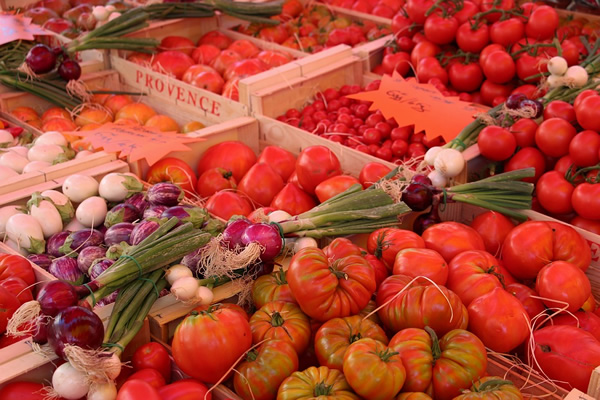
|
|
At markets in and near Avignon, you can find the most delicious vegetables, herbs, and fruits.
|
As much as driving through the countryside of Provence appeals to me, taking in the markets and stopping along the roadside for a long, lingering lunch in a county inn, this trip I wanted to get to know Provence from one place. I also wanted to explore Provence, which relies entirely on public transportation. Because Avignon was in the middle of everything, that became my home base. It was the perfect place for day trips, using the well-connected train and bus lines, and it was a wonderful place to stay.
In Avignon, you can visit the famous Les Halles d’Avignon covered market as well as take tranquil day trips to places such as the salt marshes and sandy vineyards of the Camargue, the magnificent Roman aqueduct at the Pont du Gard (and onward to Uzès for the traditional Saturday market), to Châteauneuf du Pape and Orange for Rhône wines and the Roman theatre, to the Lubéron for country markets, fantastic and bizarre wild and manmade landscapes and fertile fields, and to the cities of Aix and Marseilles.
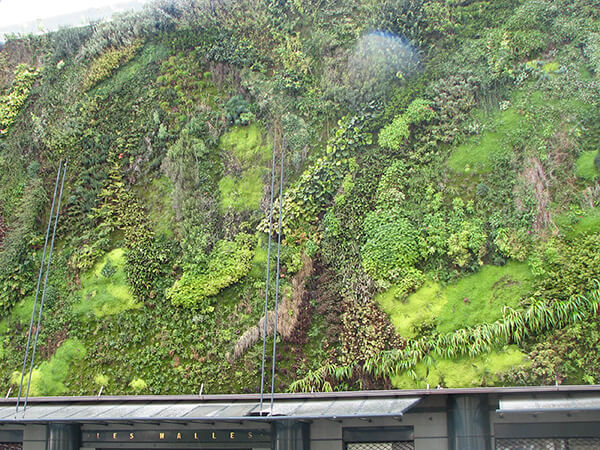
|
|
A mosaic of greens covering
the outside walls of the famous Les Halles market in Avignon.
|
I discovered the Hôtel
Médiéval run by a hospitable staff who make a person feel as if they are coming home each time she enters its stone doorway in the medieval neighborhood. The Hôtel Médiéval offers hotel rooms and a few studios with kitchenettes at a special weekly rate for those who want to stay a while, visit the city slowly while feeling home, and cook the market catch of the day. It was so pleasant that as much as I enjoyed those day trips, I also treasured staying put and visiting Les Halles and all the little gourmet shops in the walled medieval city, getting to know merchants and stands, both biologique (organic) and other local produce, cheeses, olive oils and olives, and regional wines. Slow travel feels like the only way to visit the charming city while enjoying its atmosphere to its fullest.
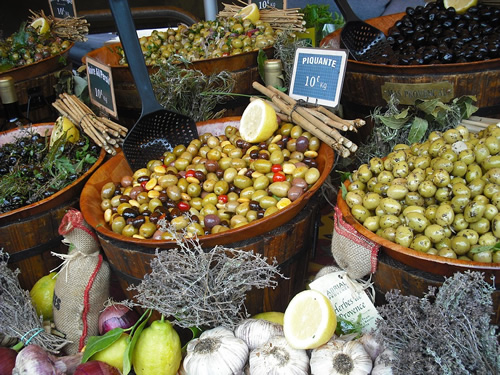
|
|
Olives, herbs, garlic, and lemons at a market in Provence are all central to the cuisine.
|
On my train journey to Avignon, I was given an education by an older man on his way to Marseilles to visit family. As we began chatting, I asked him what he thought was the best food to sample in Provence. He started with that classic shrug and then launched into a delightful monologue: “Alors, you must really try toro steak, the bulls here are truly delicious.” He gestured out the train window. To the south, the famous black bulls destined for steak live in the Camargue marshes and coast. “Next, you must have the bouillabaisse, one with all the catch of the sea in it.” “Where is the best bouillabaisse?” I asked. Another shrug. “Everywhere makes their own,” he said, but Marseilles is famous, given the location and the fishing port. “Next,” he went on, “be sure to sample the fresh produce of Provence as crudités with our special mayonnaise dip.” The divine vegetables — raw or blanched — that can go into this fresh platter with the mayonnaise dip (aioli) are carrots, peppers, celery, asparagus, turnips, radishes, green beans, fennel, cauliflower, cucumber, tomatoes, broccoli…whatever is in season. The aioli offers a garlicky spin on classic mayo, whipped up fresh with eggs, lemon juice, olive oil, finely minced garlic — or better, smashed — fresh chopped herbs, salt, and pepper.
A Memorable Provencal Meal in Nearby Arles in Provence
Arriving in Arles, the elderly man stood up, pulled my bag from overhead, and placed it in the aisle, holding the door open for me. “Welcome to Provence and bon appetit!” Not only did I take his culinary lead, but in my explorations of Provence, I discovered other people who were as consistently warm and welcoming as he had been.
All the makings for the bouillabaisse and the crudités were readily available in Les Halles. But that toro steak was something I tried in Arles. I enjoyed it at the restaurant connected with the Hostellerie des Arenes (62 Rue du Refuge, near the Roman amphitheater). I ordered the daily fixed-price menu, offering a shockingly inexpensive three-course meal and wine. It included a salade de chèvre, steak de tarreau au buerre vert with ratatouille and pommes de terre au gratin, homemade flan for dessert, and a Côte du Rhone red wine. This meal was so perfect and delicious that it has gone down as one of those epic meals one remembers for a long time. Moreover, the atmosphere of Restaurant des Arenes reinforced this experience, from the three quick and witty women who ran it to the patrons who all welcomed each newcomer when they entered the dining area and who proceeded to talk to each other across tables as if we were one large family.
Exploring Avignon
Once settled in Avignon and on day trips throughout Provence, I discovered an essential part of daily life and culture often not described in popular books expounding the bounty of Provence and her culture. I found that I had only read part of the story. Missing were the Jews, the Romany, the North Africans, and the West Africans. Missing were the influence of Italy and Spain, especially Catalonia. In Avignon, I discovered this more diverse and accurate depiction of Provence, one that reinforced the fact that since the time of the Celto-Ligurians, through to the Romans, and right up to the post-colonial French present, Provence has been a prominent crossroads in the Mediterranean, bringing in peoples from everywhere. And yes, it also possesses the wonderfully quirky, warm, and witty Provençales.
There is no better place to see this rich diversity than at Avignon’s Sunday flea market in Place des Carmes, right in front of the church and cloister, Église et Cloître des Carmes. (On Saturday, you’ll also locate the vibrant flower market in this plaza.) The Sunday flea market packs the Place with West Africans, North Africans, Provençales, and Romany, buying and selling everything from used shoes and clothes to old record albums to household goods and theatrical props. Some dramatic Louis XV-style mirrors and chairs add shabby chic to the scene. It is a Sunday, and as the market continues, so does the church service from Église des Carmes. As a shopper, you can enjoy the piped Sunday service’s sermon and the sacred songs of speakers mounted over the plaza. Like many marketgoers, I punctuated my shopping by stepping inside the church and standing in the back row to sing with the congregation, following the words on a karaoke-like screen near the altar.
Among Avignon’s many charms is its completely walled medieval city within the modern city. Numerous gates lead into this walled town. The rush of traffic is limited to the very few main streets, leaving many pedestrian-only passages. Though the popes who built this old town were a feisty lot, they left a stone medieval city that enchants residents and visitors alike. And while the Pont d’Avignon is most famous because of its catchy primary school song, I think Avignon should be renowned for its warm people, its access to regionally grown and produced foods and wines, and its fairytale-like setting on the Rhône, giving it easy access to Arles, Orange, Gordes, Aix, Marseilles, Les Baux, the Pont du Gard, and on into the lavender, calabash, melon, auberge, apple orchards, and wine-producing vineyards throughout Provence.
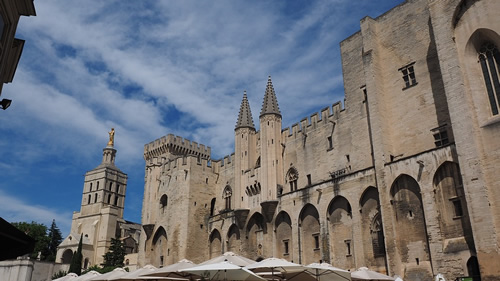
|
|
The Palais des Papes in Avignon.
|
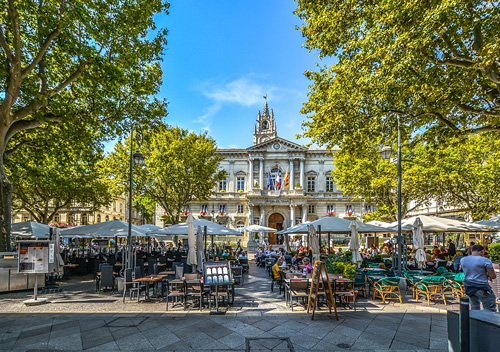
|
|
Taking it slow at a café on
the Place de l'Horloge in Avignon.
|
Avignon was occupied long before it became the residence of Popes in the 13th and 14th centuries. A stroll along the gardens of Rocher des Doms will take you to an area, also within the walls of the medieval city, first occupied in prehistory, then in the Bronze Age, and again in the Iron Age when it became the site of an oppidum, a Celtic-style fortress. The Romans then settled Rocher des Doms. After the Romans, it was forgotten as a human settlement and used as grazing land in the medieval period. Around 1830, the Rocher des Doms was converted into a garden.
Here are a few suggestions for enjoying Avignon at the pace of a slow traveler:
Suggestions for enjoying
Avignon as a slow traveler:
-
Take in the sunset in the gardens of the Rocher des Doms overlooking the Rhône to the west and north. The numinous pink sunset on the Rhone is worth it, but do be forewarned, as the sun sets, some of the world’s most voracious mosquitoes, guardians of the Rhône and nearby Camargue no doubt, emerge with the speed of Genghis Khan’s army. Many guidebooks warn of mosquitoes through the warm summer months. Still, I was there at the tail end of September, and they were as unrelenting as in July.)
-
Walk along the wall and within it, exploring the different gates. Take the famous bridge, Pont St-Bénézet, for its sing-song and historical fame and lovely view of the Rhône river valley.
-
Dip into the little courtyards open to the public and off the narrow streets in the walled city. Usually, an art exhibit is housed in one of the interior courtyard buildings. These places also offer delightful peace and relaxation.
-
Explore for a good part of a day the huge Gothic Palais des Papes and immerse yourself in the two-century-long Avignonese papacy of the 14th and 15th centuries when Avignon became the residence of the Popes (1309) to leave behind the warring political factionalism in Rome. However, by 1378, with the election of Pope Clement VII, a division emerged between Roman Popes and Avignonese Popes, which lasted until 1417. (The Avignon popes were mainly acknowledged in Naples, France, and Spain.) During that time, the popes in Rome and Avignon competed with and denounced each other as they vied for mortal power. At the same time, the city of Avignon flourished because of papal patronage. After the papal reunification in Rome, Avignon continued under papal control until 1792. The revolution ended this, making Avignon a part of France.
-
Take in the many small food, oil, and wine boutique shops in the walled city, where you can buy locally made olive oils, soaps, essential oils, olives, medicinal brebis (sheep’s milk) cheeses, medicinal sausages, flowers, and fruits and vegetables of the season.
-
Visit Les
Halles d’Avignon as your daily stop for fresh, locally produced, and procured foods and wines. Les Halles is open every day except Mondays at Place Pie. There, you will also find organic growers and producers.
-
Avignon is the heart of Côte du Rhône country and, therefore, a great place to explore this stellar appellation. A good start is checking out the local wine stores, including at Les Halles, which usually stock some of the great wines in the region. (If you really want to explore the region and truly love wine, there are a wide variety of wine tours that will take you all over Provence and include transportation.)
A budget note for hardcore epicurians: the
special sea salt from the Camargue makes a wonderful souvenir
and gift but don’t buy it in the tourist shops where
it is two to three times more expensive. Instead, the very
same container of salt can be purchases at any of the many
everyday small markets scattered throughout the city.
Beebe Bahrami is a freelance writer and cultural anthropologist specializing
in travel, food and wine, and cross-cultural writing.
|
Related Topics
|
|
Culinary
Travel
|
|
